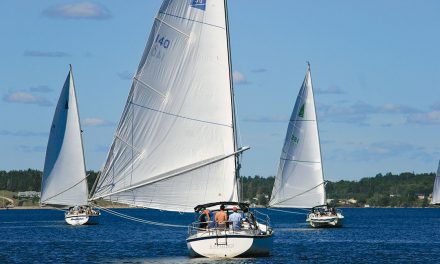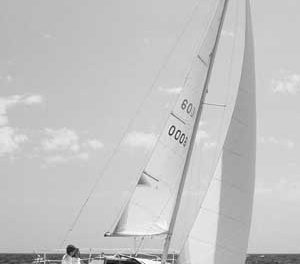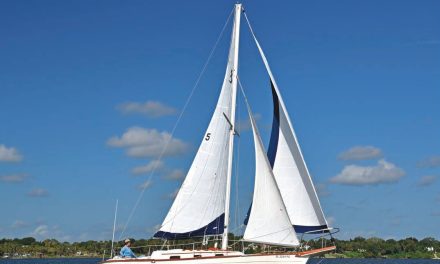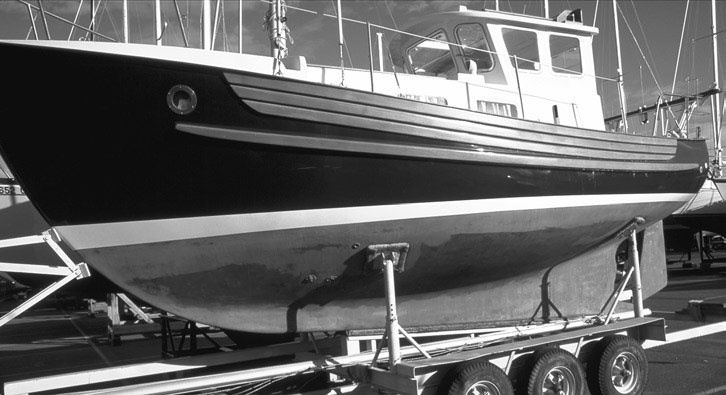
Ted Brewer reviews the ins and outs and ups and downs of keel design
The purpose of a keel, fin, or centerboard is to provide resistance to making leeway; in effect, to keep the yacht from sliding sideways through the water due to wind pressure on the sails. Various shapes of underwater plane have been in and out of style over the past 150 years.

The highly stylized shark fin has extreme rake and a sloping tip chord.
The basic full-keel shape had the longest run, as it was the standard for bluewater sailing craft from pre-Roman times to the earliest days of yachting. The deep, full keel was supplemented in the mid-1800s, for the shoalwater areas of Britain and North America, by centerboard craft. These cover such working types as the sharpies, Cape Cod catboats, and Chesapeake Bay oyster skiffs, to mention a few.
The first truly modern keel yacht, with a cutaway forefoot and highly raked rudder post, was designed by Capt. Nathanael Herreshoff with his Gloriana design of 1891. But it did not catch on for bluewater sailing. Until the late 1920s, the typical offshore yacht, whether cruiser or ocean racer, resembled a sailing fishing craft in the shape of its lateral plane: a long, full keel with deep forefoot and fairly vertical sternpost. Such a shape has the benefits of good directional stability, ease of steering, and the ability to heave to in heavy weather, all desirable traits for a boat. However, its faults may include slowness in stays, excess wetted surface making it slower in all types of air and an inefficient lateral plane shape that has excess leeway, considering its relatively large area. Typical small yachts of this type are seen today in the Colin Archer types and the Tahiti ketch and its copies, while replicas of traditional sailing craft such as Bristol Channel Cutters, Friendship sloops, fishing and pilot schooners, and similar lovely vessels still appear in our waters. Fortunately, many of these workboat types have been developed to the point where the ills of the true full keel have been greatly reduced. Then the result is a handsome cruiser that sails quite well and attracts a great deal of attention wherever she drops her hook.
Successful Sailboat Keel Types
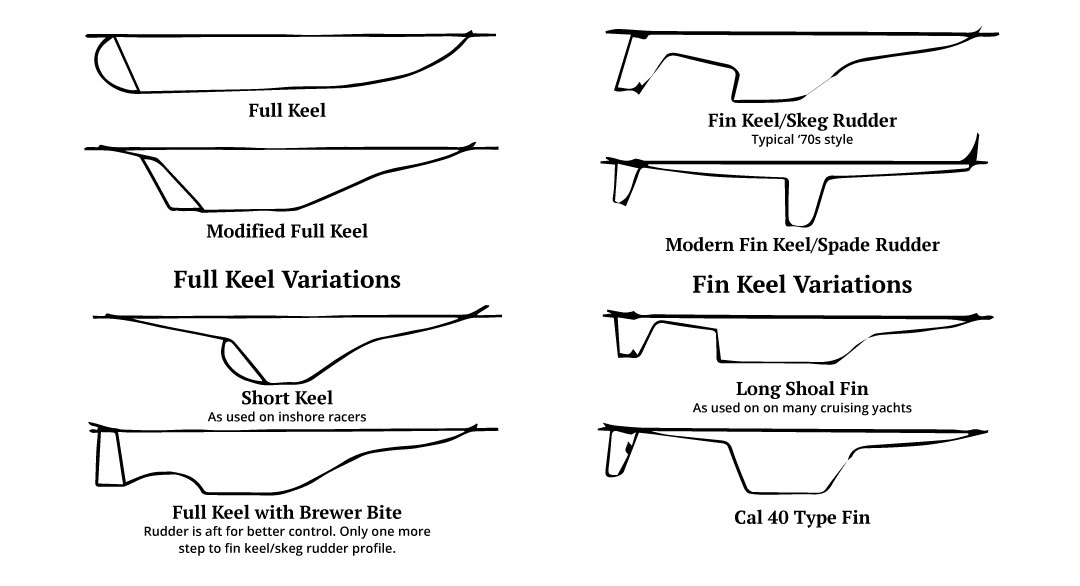
The cutaway keel was revived for ocean racing by Olin Stephens in the late 1920s, with his lovely yawl, Dorade, still sailing and winning classic yacht races more than 70 years after her launching. Her offshore racing successes finally proved that the full keel was not essential to seaworthiness, and it definitely detracted from speed and weatherliness. As a result of its improved performance and handiness, the “modified full keel” form caught on quickly once Dorade showed the way and became the standard for the next 35 years. This type of lateral plane is still sailing in many popular older designs such as the Albergs, the Folkboat, the Luders 33, the Whitby 42, and even some newer yachts.
The modified full-keel form features generally good handling and directional stability plus reduced wetted surface, compared to her true full-keel sister. The yachts can perform well in all conditions and, as they are generally of heavier displacement than contemporary ballasted-fin boats, they do not give away much in light air, despite the added wetted area. A yacht with a modified full keel can sail right up with the best of them if she is given sail area commensurate with her typically heavier displacement.
In my own work, I developed a modified full keel, with the rudder set aft and vertically in the contemporary fashion, in order to improve directional stability and handiness. Then, to reduce wetted area, the lateral plane is substantially cut away ahead of the rudder in what some have termed “the Brewer bite.” The Cabot 36 and Quickstep 24 of my design were early examples of this form. The size of the cutout depends to a large degree on how insistent my client is on having a “full keel,” and I try to make the cutout as large as I can decently get away with. I don’t claim to have originated the shape, though, as the late L. Francis Herreshoff used a not dissimilar profile many years earlier in the design of the lovely 57-foot ketch, Bounty.
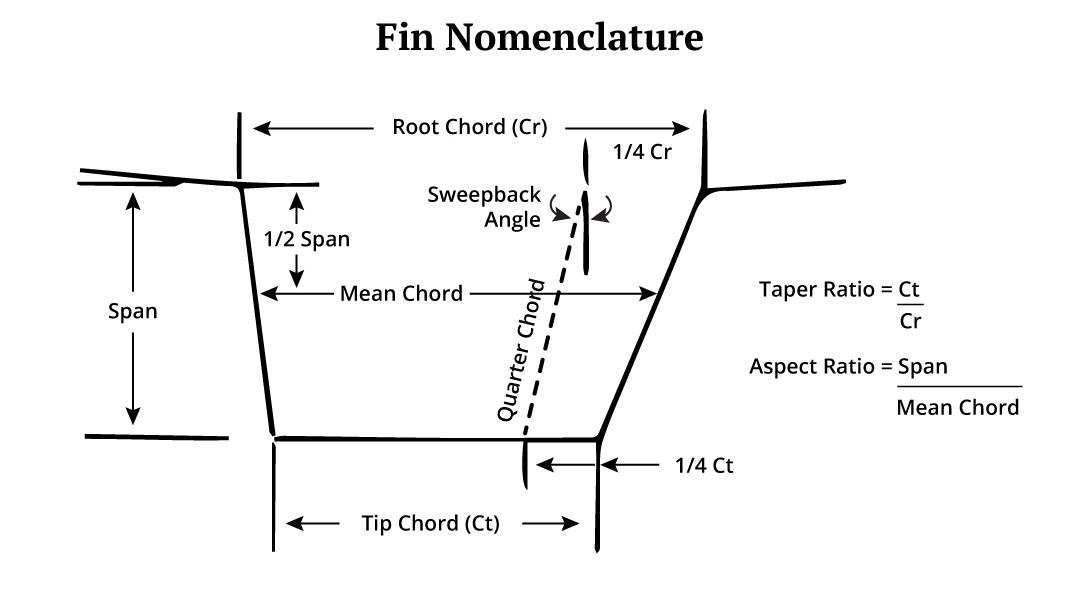
Taken to Extremes
Like all good things, the modified full keel was cut away more and more for bluewater and inshore racers in an attempt to reduce wetted area until, finally, some designers took it to extremes. This reduced directional stability and produced craft that were almost impossible to steer in breezy conditions, broaching with monotonous regularity. I can recall working on the design of many short-keel 5.5-Meter yachts in the 1960s, and we always said they were three-man boats with six-man spinnakers! It’s hard to believe none of them were knocked down and sunk, as they were extremely difficult to control on a reach or run, and the hulls were pure leadmines, with 3,500 pounds of ballast in their very short keel and only 1,000 pounds of wood and rig above it!
Olin Stephen’s genius began another fad in the mid 1950s, the keel-centerboard design. After Finisterre showed the way, keel-centerboard yawls were built in sizes from 24-foot midget ocean racers, to the largest offshore yachts, in order to take advantage of favorable ratings under the CCA rule and emulate Finisterre’s record of wins. The keel-centerboard hull has gone out of fashion now, but the type still has merit where a stable, beamy, shoal-draft yacht is desired with little sacrifice of weatherliness or seaworthiness. Indeed, the Bill Tripp-designed Block Island 40 and Bermuda 40 are keel-centerboard ocean racers from the old school and have been in production for more than 30 years now. These classic yachts have made many long ocean voyages, including several world circumnavigations and are first-class bluewater cruisers in every respect.
Keel Types Here to Stay

A rather squared-off fin, not unlike the Cal 40 keel.
The fin shape is not new either, as ballasted fin yachts were pioneered by Herreshoff at the turn of the century for inshore racing. Then, due to excesses and bad design, the shape died out, except for a few one-design classes, until Bill Lapworth dropped a bomb on the ocean-racing scene in the mid-1960s with his Cal 40 design. The Cal 40s made believers out of many yachtsmen who could not believe that a ballasted-fin/spade-rudder yacht was a serious bluewater ocean racer. After wins in the Trans-Pac, many East Coast races, and the 1966 Bermuda Race, it became evident that the fin was here to stay for ocean-going and coastal cruising yachts. Please note that I do not use the term “fin keel” anymore, as I feel it is a misnomer. The keel is the structural backbone of the vessel, and the fin hangs from it. Fish have both backbones and fins; so do yachts.

A less extreme fin keel, with a more parallel tip.
A well-designed fin, in conjunction with a skeg-hung rudder, can provide excellent directional stability, handiness, reduced wetted area and improved weatherliness. The fin/spade rudder combination reduces wetted surface even more. It may have a little (or a lot) more sensitive helm than a fin/skeg rudder yacht, but it has one big advantage over it and all other forms of lateral plane: it can be steered in reverse under power. This can make life a great deal easier in today’s crowded marinas, as many have discovered.
These are some of the reasons that we see fins on the great majority of our new yachts today; they are not simply a fad. There are good fins and bad fins, of course, and it is not always easy to tell them apart. The shape of fins over the years has been limited only by the designer’s imagination. Fins have been set at every angle from the vertical to highly raked aft. They have been deep and narrow, shoal and long, resembling a shark’s fin or whale’s tail, or boxy fins similar to the original Cal 40 design.

A contemporary bulb fin with winglets.
Major Problem
A very deep, narrow fin can be a problem to haul on a marine railway, so the cruising skipper should consider haulout ease when boat shopping. A crane or travel lift is the best method for hauling yachts with extreme fins, but may not always be available in out-of-the-way areas. There is also the danger of damage to the shaft or strut if slings are improperly positioned. Still, the major problem of the high-aspect-ratio fin is structural strength, as it can impose extreme loads at the point of attachment to the keel. Indeed, some years ago I was an “expert witness” in a court case concerning three men who drowned when their yacht sank as a result of its fin tearing off when the vessel ran aground.
The cruising skipper would do well to avoid yachts with extreme fins, both for considerations of haulout ease and structural strength. Fortunately, the heavier, deeper hull and generally shoaler draft of the typical cruising yacht mean there is less height available between the bottom of the hull and the point of maximum draft. So, a longer, lower-aspect-ratio fin is the only solution. On the other hand, the racing sailor will want a fin with an aspect ratio as high as the draft rule will allow. Such a fin is more efficient per square foot, so the area can be smaller and the wetted surface reduced. In Aero-Hydrodynamics of Sailing, C.A. Marchaj recommends about 4 percent of the sail area as a good guide for fin area, and I feel the cruiser should err on the high side, as a small increase in resistance is preferable to increased leeway. On the other hand, I have used as low as 1.75 percent area with good results on an extreme racer with a fin of 2.75 aspect ratio.
Sailboat Keel Aspect Ratios
This “aspect ratio” is the ratio of the span (depth) squared to the fin area; that is, my extreme fin had an 11-foot span and 44 square feet of area, so its aspect ratio was 121/44, or 2.75. If it had a 4-foot span with 44 square feet of area, not uncommon proportions for a cruising yacht, its aspect ratio would be 16/44, or a low 0.3636.
The aspect ratio can also be described as the span divided by the mean chord, the average fore-and-aft length of the fin, and this gives the same result.
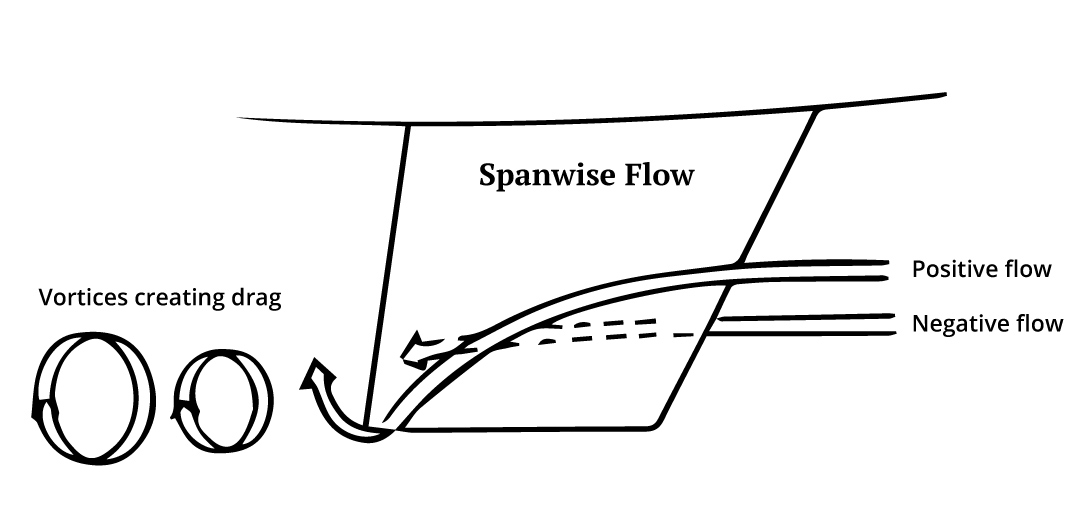
A large part of the resistance of a keel is created by the vortices, similar to miniature whirlpools that form when the water flows across the bottom of the keel from the high-pressure (leeward) side to the low-pressure (windward) side. It requires energy to form those vortices and that energy is then not available to propel the boat forward. Obviously, the shorter the keel or fin tip, the smaller and weaker those vortices will be, and that translates to reduced resistance. This is one reason that racing yachts usually feature high-aspect-ratio fins with short tip chords.
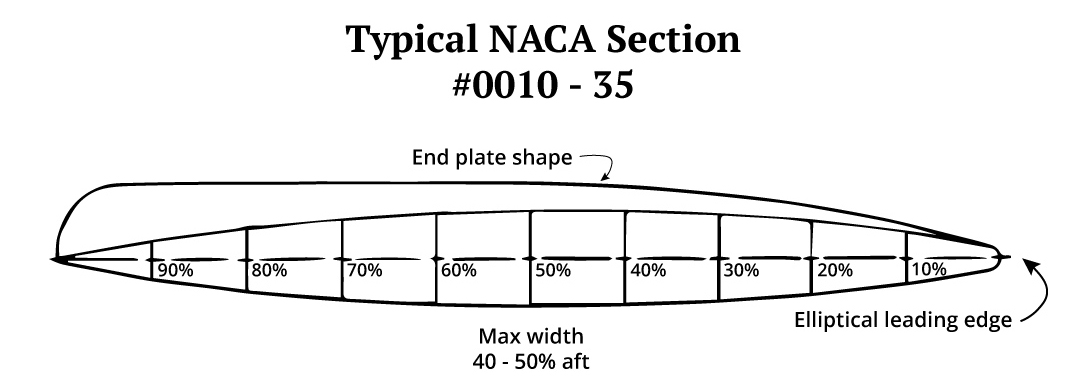
However, the formation of vortices can be greatly reduced by using end plates, or wings, to change the flow direction and eliminate crossflow. My own preference, for a fin of average span, is for an end plate that is but a few inches wider than the maximum width of the fin bottom. We tested an actual yacht with such an end plate on one side only and noted a substantial improvement in performance when she was heeled so that the end plate was on the leeward side. Where the draft is shoal and the fin span is on the small side, then a wider end plate, or even a wing, might prove beneficial. However, a wide wing can be a structural weakness, particularly if the boat goes hard aground and has to be towed off, or pounds on the rocks for any length of time.
Sweepback Angles
In the 1970s, I saw more than one very-high-aspect-ratio fin with tremendous sweepback angle. This certainly gives an impression of speed but, as Marchaj pointed out, tank tests have shown that the sweepback angle can be related to the aspect ratio: the higher the aspect ratio, the more vertical the fin should be. Indeed, the very-high-aspect-ratio fin on my BOC racer was set absolutely plumb until a hard grounding set the tip back a quarter inch or so, the result of taking a yacht with a 13-foot draft through a channel dredged to 11 feet! Most cruising-yacht fins are of low aspect ratio, of course, so should have substantial sweepback, up to 57 degrees, with an aspect ratio of 0.5, according to Marchaj. Although most designers try, it is unfortunate that obtaining the perfect sweepback angle is secondary to locating the fin to balance the sailplan, as well as fitting the ballast at the correct spot for proper fore and aft trim. The taper ratio (tip chord length/root chord length) also deserves consideration. Tests on one series of fins showed that a fin with 0.32 taper ratio was 1 percent more efficient than an untapered fin and had very slightly less resistance. This is a small difference but cannot be ignored by the racing skipper. Again, the reduction in drag may be due to reduced vortices from the shorter tip chord. Marchaj also states that the taper ratio should be reduced as the sweepback angle increases. However, the very-low-taper-ratio fins may not be the best solution for a cruising yacht. The tip chord should be long enough so the vessel can be hauled on a marine railway with no major problems. Too, on a moderate-draft cruising yacht, a short tip chord forces the ballast higher, so stability can suffer.
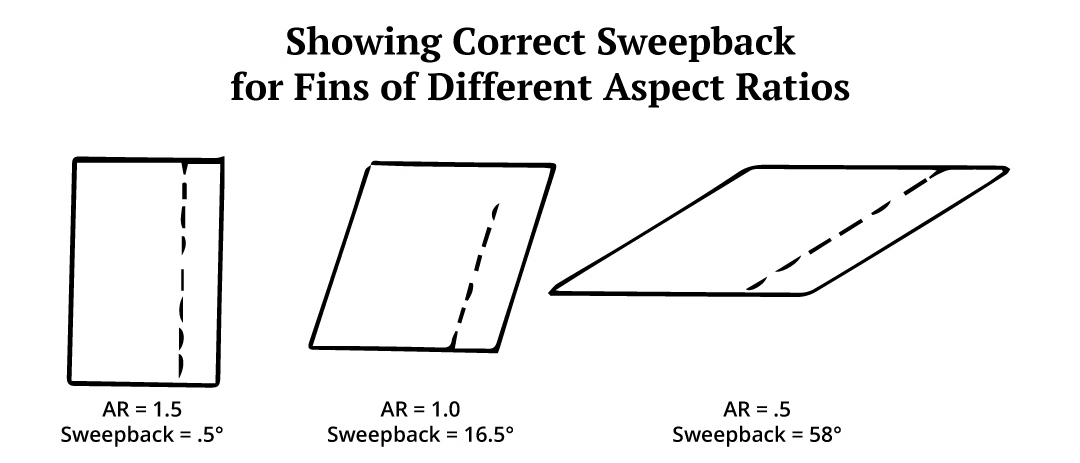
Lower Ballast
Another consideration in the fin profile is whether the tip chord is sloped down aft or parallel to the waterline. The parallel tip chord makes good sense. It allows the ballast to be lower for added stability, it eases blocking up the boat when hauling and, fortunately, tests have shown that it is also superior to the sloped tip chord in other ways. Having the aft edge of the tip chord deeper than the leading edge has no practical effect on aspect ratio, and such a fin develops less lift and more drag than one with a parallel tip.
The National Advisory Committee for Aeronautics (NACA) tested a large variety of streamlined shapes for lift and resistance and the information on these is available in a book, Theory of Wing Sections, by Abbot and Von Doenhoff. These are the shapes that designers refer to when they say their new magic fin has an NACA section. Generally, the shape selected will be similar to NACA 0010-34 or 0010-64 series. The leading edge will be elliptical, as a blunted nose increases resistance while a pointed leading edge promotes stalling. The maximum width will be about 40 to 50 percent aft, and the shape will be streamlined to a fairly sharp (but not razor-sharp) trailing edge. The thickness ratio will be 0.8 to 0.12 of the chord length, although this may be increased to 0.15 to 0.16 at the tip chord. There are advantages to having an increase in thickness ratio at the tip chord, including being able to fit the ballast lower. This need not mean that the fin is bulbed, though. For example, a fin that is 8 feet long at the root and 5 feet long at the tip may have a 0.10 thickness (0.8 feet) at the root and 0.15 thickness (0.75 feet) at the tip. The fin is still slightly thinner at the bottom than at the top, but the thickness ratio has increased.
Increased Resistance
It is not uncommon to see fins wider than 10 to 12 percent of their length, as the designer may need to fatten the fin in order to locate the ballast in the correct spot for proper trim. Very shoal-draft boats may require fatter keels or fins in order to get the ballast as low as possible for stability. Still, extra width does increase resistance so there is a tradeoff; added stability increases performance while a thicker fin reduces performance. Thirty-five years ago, when I worked for Bill Luders, we tank-tested dozens of 5.5-Meter models. These very short-keeled 30-foot sloops had a minimum keel width of 4 inches under the rule, and whenever we tried a model with a wider keel in order to get the ballast lower, we found that overall performance suffered.
We also tested a number of bulb keels on the 5.5 models but they never proved out in the tank, either, although several different shapes were tried. Then, in the late 1970s, I tank-tested the model of the new Morgan 38 at Stevens Institute, first with a fairly fat NACA fin in order to maintain the desired 5-foot draft, and then with a patented bulb fin that we let its designer draw up, with no stipulation on draft. The bulb saved only 2 inches of draft but showed so poorly against the NACA fin that the 38 was put into production with the more conventional shape.
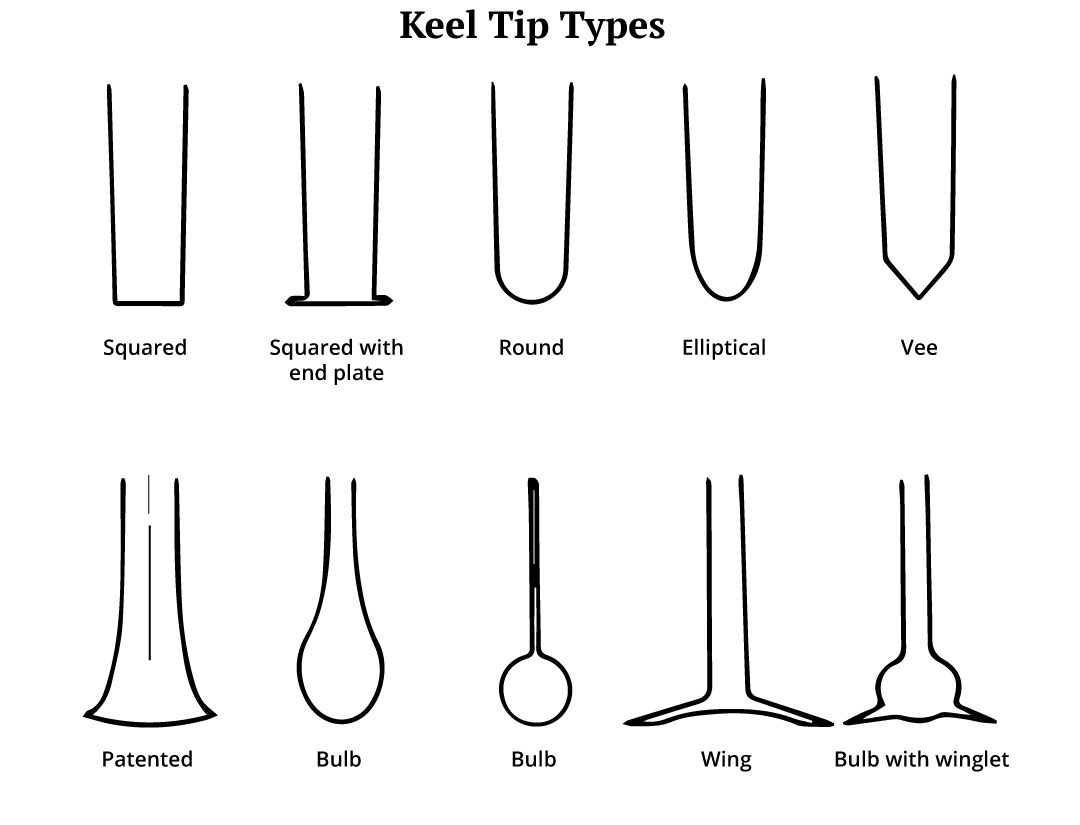
The tip shape, viewed from ahead, may be flat, round, elliptical, or bulbed. Tests show that the flat, squared-off tip develops a bit more lift to windward and that the round or elliptical tip has less drag on a run. The differences are slight but, today, I favor the squared-off tip with an end plate for yachts of average draft. A vee tip was tried in the 1960s on a few yachts, but never became popular. Bulbs and wings, often in combination, are fairly common on contemporary production boats. Usually, they are an attempt to produce a very shoal-draft yacht for use in waters where the bottom is close to the top and, in those cases, they may make sense.
There is a never-ending variety of fin shapes and, to be honest, I’m not sure which is best. Generally, I prefer a fin similar to the old Cal 40, a little shorter perhaps, and fitted with an end plate. Such a fin provides a desirable combination of good performance, ease of haulout, and structural strength, all very important factors for the cruising skipper.
Article first appeared Good Old Boat magazine: Volume 3, Number 4, July/August 2000.

